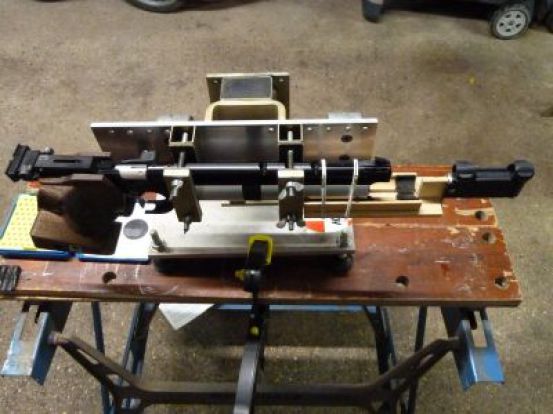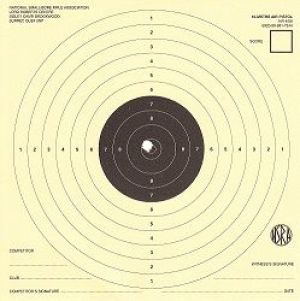Pellet Performance
Advanced pellet testing with the Steyr LP10E pistol at 10 metres
It is quite some time since we carried out any serious pellet comparisons tests and we have not had a chance to put the new pistol test rig into action.
The object of this comparison test is to establish two related, whilst different factors, which are as follows.
1) To determine the difference and variation in the muzzle velocity when using RWS R10 4.49 air pistol and RWS R10 4.49 air rifle pellets without making any adjustment to the Steyr LP10E pistol.
2) To determine the size of the strike pattern on the target and the change in the point of impact without making any changes to the test rig or the pistol.
The RWS R10 4.49 air pistol pellets that were used weigh 7.0 grains or 0.45 grams and the RWS R10 4.49 air rifle pellets that were used weigh 8.2 grains or 0.53 grams.
It was thought that the difference in the pellet weights should make some noticeable difference in both the muzzle velocity and the point of impact.
The temperature during the whole test was 16°C and the relative humidity was 70%RH, so the flight of the pellets should not be adversely affected.
The test rig was set up at 10metres, the Steyr LP10E was positioned in the rig and the Combro CB625 chronoscope was fitted to the pistol. A few test shots were fired to establish a representative point of impact using the air rifle pellets.
None of the pellets used were selected, they were taken at random straight from the respective tins, as we did not want to create an artificial or controlled pellet input.
Ten shots were fired using the RWS R10 4.49 Air Rifle pellets and the muzzle velocity was recorded for each shot as follows:
RWS R10 4.49 Air Rifle Pellets
505 fps 504fps 501fps 500fps 502fps
499fps 503fps 501fps 499fps 504fps
The average velocity was 501fps with a deviation of 6fps.
The deviation achieved was well within the expected tolerance of 10fps.
The ten shot group created by the air rifle pellets has not been modified or electronically enhanced and shows a good, centrally placed point of impact group in the diagram. The maximum size of this group is 8mm across.
A new target was carefully fitted to the frame and without making any adjustments to any of the equipment.
Ten shots were fired using the RWS R10 4.49 Air Pistol pellets and the muzzle velocity was recorded for each shot as follows:
RWS R10 4.49 Air Pistol Pellets
552fps 557fps 553fps 552fps 555fps
550fps 559fps 558fps 554fps 557fps
The average velocity was 554fps with a deviation of 9fps.
The deviation achieved was again well within the expected tolerance of 10fps.
The ten shot group created by the air pistol pellets has not been modified or electronically enhanced and shows a good, however slightly higher and to the left placed, a point of impact group in the diagram. The maximum size of this group is 6mm across.
The change in the position of the point of impact has obviously been caused by the considerable increase in muzzle velocity, however considering that this represents a 10% increase in the muzzle velocity, without any changes to the point of aim, all of the shots from the lighter air pistol pellets have still remained well within the ten scoring ring.
Upon closer inspection, the achieved group size is fractionally smaller using the air pistol pellets than the one obtained using the air rifle pellets. It was also noticed that the heavier air rifle pellets were not cutting quite as clean a hole in the target.
From the several previous pellets test that have been carried out over a period of time, it had been established that the Steyr barrels appear to perform the most consistent with a muzzle speed of about 525fps.
Therefore it is possible that the size of the air rifle pellet point of impact group might become slightly improved if the muzzle velocity had been increased to 525fps and likewise there may also have been an improvement to the shape of the air pistol pellet point of impact group if the muzzle velocity had been reduced.
The increased muzzle velocity might also have improved the quality of the holes created by the air rifle pellets and should, in theory, have moved the point of impact up slightly, to bring it nearer in comparison to the point of impact group achieved with the air pistol pellets.
These theories are pure conjecture as it was neither practical nor intended to start making adjustments to the Steyr LP10E air regulator, as the sole purpose of this comparison test was to establish the physical difference in the point of impact group for the two different weights of pellets.
Whilst both types of air pellets tested have proven to be capable of maintaining a very good group which would be well within the ten ring.
However from these fairly small sample figures, despite the considerably lower deviation in the muzzle velocities of the air rifle pellets, which ought to give a more consistent trajectory, it would appear to be favourable to continue using the RWS R10 4.49 air pistol pellets for 10 metre pistol target shooting.
Pellet testing session 2.pdf
Adobe Acrobat document [138.4 KB]
Pellet group testing of Steyr Sportwaffe[...]
Adobe Acrobat document [211.9 KB]
For full details please contact coaching@tenrings.co.uk
All images are the copyright © of Tenrings Coaching and www.tenrings.co.uk unless otherwise stated.






